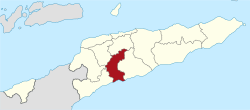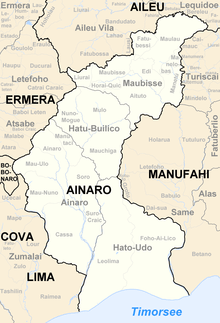Ainaro Municipality
Ainaro (Portuguese: Município Ainaro, Tetum: Munisípiu Ainaru) is one of 13 municipalities of East Timor, in the southwest part of the country. It has a population of 59,175 (census 2010) and an area of 804 km².[2] Its capital is the city of Ainaro, a small mountain town.
Ainaro Ainaru | |
|---|---|
 Maubisse village | |
 Flag | |
 Map of East Timor highlighting Ainaro Municipality | |
| Coordinates: 9°05′S 125°29′E | |
| Country | |
| Capital | Ainaro |
| Administrative posts | Ainaro, Hato-Udo, Hatu-Builico, Maubisse |
| Area | |
| • Total | 804 km2 (310 sq mi) |
| Area rank | 9th |
| Population (2015 census) | |
| • Total | 63,136 |
| • Rank | 10th |
| • Density | 79/km2 (200/sq mi) |
| • Density rank | 6th |
| Households (2015 census) | |
| • Total | 10,601 |
| • Rank | 9th |
| Time zone | UTC+09:00 (TLT) |
| ISO 3166 code | TL-AN |
| HDI (2017) | 0.560[1] medium · 12th |
Etymology
The word Ainaro is a Portuguese approximation of the local Tetum and Mambai language word Ainaru, which means "tall tree".[3]
Geography
Ainaro has a great abundance of rivers and fertile terrain for agriculture. It has a coastal area, on the Timor Sea, but also mountainous zones, including the highest point in East Timor, Mount Ramelau (2,960 m), also known as Tatamailau, which lies near the border with Ermera.
The borders of the municipality are identical to that of the same in Portuguese Timor, with the following exceptions: during the Indonesian occupation, the then subdistrict of Turiscai became part of Manufahi from Ainaro, and the then subdistrict of Hato-Udo became part of Ainaro in exchange. The then subdistrict of Mape-Zumalai became part of Cova Lima in 2003.
The municipality borders Aileu to the north, Manufahi to the south, Cova Lima to the southwest, Bobonaro to the west, and Ermera to the northwest.
 Borders of Ainaro before 2003
Borders of Ainaro before 2003 Borders of Ainaro after 2003
Borders of Ainaro after 2003 Cities and rivers of Ainaro
Cities and rivers of Ainaro
History
Ainaro played an important role during the brutal Indonesian occupation of East Timor, providing shelter for the mountain-based guerrilla resistance army. Former guerrilla leader and current President Xanana Gusmão spent many years directing the resistance from Ainaro.
Administrative posts
The municipality's administrative posts (formerly sub-districts) are:[4]
- Ainaro Administrative Post (place of capital)
- Hato-Udo Administrative Post
- Hatu-Builico Administrative Post
- Maubisse Administrative Post
Demographics
Languages
In addition to the official languages of Tetum and Portuguese, a large number of inhabitants of Ainaro speak the Malayo-Polynesian language Mambai.
Religion
The inhabitants include catholics, protestants, and muslims living side by side.
References
- "Sub-national HDI - Area Database - Global Data Lab". hdi.globaldatalab.org. Retrieved 2018-09-13.
- "Rezumu hosi Rezultadu Prinsipál Sensu 2010 iha Timor-Leste" (PDF). La'o Hamutuk. 2011. Retrieved 2017-02-22.
- Hull, Geoffrey (June 2006). "The placenames of East Timor" (PDF). Placenames Australia: Newsletter of the Australian National Placenames Survey: 6–7. Archived from the original (PDF) on 2017-02-14. Retrieved 4 June 2018.
- Gunn, Geoffrey C (2011). Historical Dictionary of East Timor. Lanham, Maryland: Scarecrow Press. p. 36. ISBN 9780810867543.